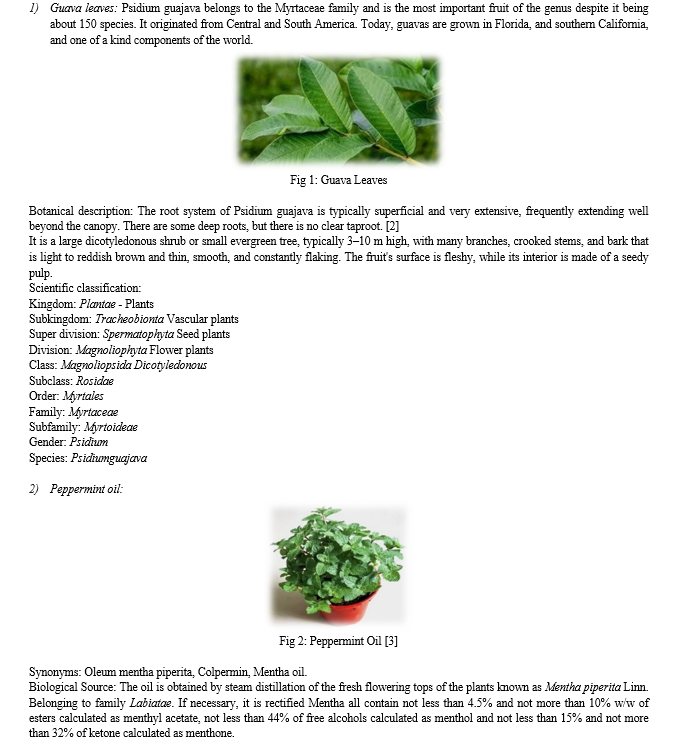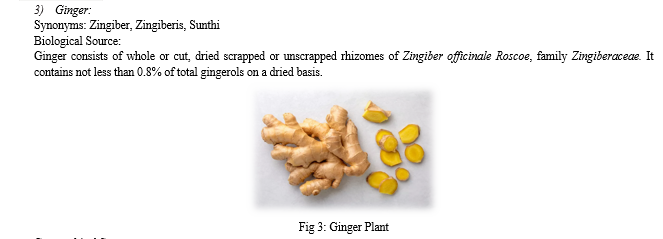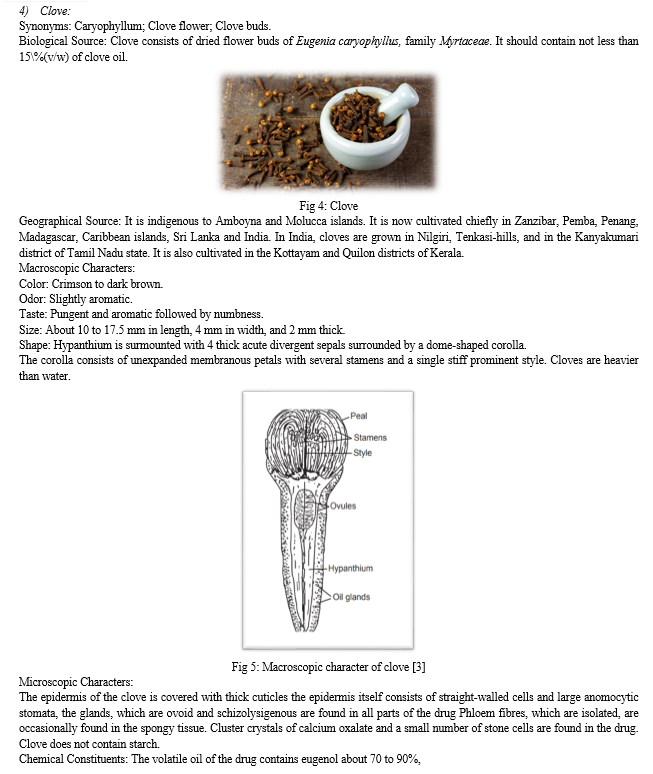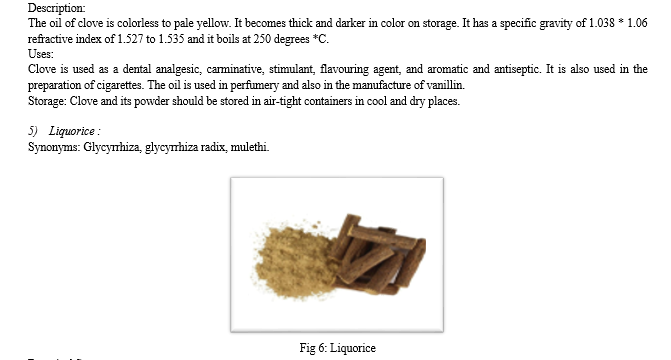Ijraset Journal For Research in Applied Science and Engineering Technology
- Home / Ijraset
- On This Page
- Abstract
- Introduction
- Conclusion
- References
- Copyright
Formulation and Evaluation of Herbal Mouthwash
Authors: Mr. Vishal S. Shingare, Mr. Ajay L. Sonkamble, Mr. Swapnil S. Sontakke, Principal. Mr. Yuvraj Girbane, Assist. Prof. Mrs. Priyanka T. Deshmukh
DOI Link: https://doi.org/10.22214/ijraset.2024.61992
Certificate: View Certificate
Abstract
The goal of the existing work is to formulate and compare natural herbal mouthwash and to assess its effectiveness against microbial load of the oral cavity. The main combinations are Guava leaves, Neem, and other herbal ingredients. Patients and oral health practitioners are faced with a multitude of mouthwash products containing different active and inactive ingredients. Although many popular herbal products have helped to control dental plaque, anti-inflammatory activity, analgesic action, and gingivitis, they have been used for a short time and only as an Adjunct to unique oral hygiene measures in conjunction with brushing and flossing. Mouth ulcers are small sores that form on your gums, lips, tongue, inner cheeks, and roof of your mouth. Different formulations are used for mouth ulcers/canker sores, such as pastes, gels, tablets, paints, and mouthwashes. Psidium guajava Linn. (guava) is used as a meal and additionally as people\'s remedy in subtropical regions around the arena due to its pharmacologic activities. Hence there is a need for increased usage of herbal preparation to avoid the adverse effects. This answer may be used to lessen the microbial boom inside the oral. This examination is an try and define such herbal substances, that can be used as powerful and effective mouthwashes.
Introduction
I. INTRODUCTION
Mouthwash: Herbal mouthwash is the mouthwash that is prepared from natural plant extract, the natural extract present in the herbal mouthwash is obtained from various plant leaves, fruit, seeds, and various tree oils. Phytochemicals are naturally occurring ingredients found in herbal mouthwashes, which have the used for anti-inflammatory action. Herbs having antimicrobial mouth ulcer cure properties, such as neem, guava leaves, etc., are found in many herbal mouthwash. Some of the plants found in mouthwashes include peppermint, which has a cooling impact on the mouth, and clove, which has long been used for oral health due to its antiseptic, antibacterial, and antiviral properties. Natural remedies for oral health issues, including clove oil, neem, Triphala, tulsi, and pudina, have been shown in studies to be safe and effective when used alone or in combination. [1] Oral fitness is a key indicator of common fitness, health, and pleasantness of life. WHO defines oral fitness as “a kingdom of being unfastened from the persistent mouth and facial pain, oral and throat cancer, oral contamination and sores, periodontal (gum) disease, teeth loss, and other disease and disorder that limits an individual capacity in biting, chewing, smiling, speaking and psychosocial wellbeing”. World Health Organization (WHO) in 2003. Traditional natural drug treatments are plant-derived materials that have been utilized in the neighborhood or local restoration remedy techniques with very little business processing to therapy illness.
In the field of medicine, traditional herbal remedies are gaining popularity. In the remedy of SARS, conventional Chinese natural remedies performed a key role. Many traditional herbal medicine studies will be evaluated by the global health community. [2] Traditional herbal medicine research has been heavily funded by China, India, Nigeria, the United States of America (USA), and the World Health Organization. Phytogenic agents are traditionally used by herbalists and indigenous healers for the prevention and treatment of ulcers. Ethnomedicine, which refers back to the examination of conventional clinical practice, is a vital part of the way of life and the translation of fitness with the aid of using indigenous populations in lots of components of the world. For example, Indian Ayurveda and conventional Chinese medicinal drugs are most of the maximum enduring people's drug treatments nevertheless practiced. These structures attempt to sell fitness and enhance the pleasant of life, with cures primarily based totally on the usage of indigenous capsules of herbal origin. Given that flora has been broadly used as natural medicine, numerous methods at the moment are being used to find new bioactive compounds. Mouth ulcer: A mouth ulcer (additionally termed an oral ulcer, or a mucosal ulcer) is an ulcer that takes place at the mucous membrane of the oral cavity. A mouth ulcer is a sore that looks everywhere inside your mouth. These sores are generally red, yellow, or white, and you may have one or several. They are painful spherical or oval sores that shape inside the mouth, specifically at the inner of the cheeks or lips. Mouth ulcers are very common, and they occur in association with many diseases and by different mechanisms, but usually, there is no serious underlying cause Common causes of mouth Ulcers consist of dietary deficiencies together with iron, nutrients especially B12 and C, bad oral hygiene, infections, stress, indigestion, mechanical injury, meals allergies, hormonal imbalance, pores, and skin ailment, etc.
Mouth ulcers, additionally called aphthous ulcers, may be painful even when eating, drinking, or brushing teeth.
Drug Profile:


Geographical Source :
It is said to be native to South East Asia but is cultivated in Caribbean islands, Africa, Australia, Mauritius, Jamaica, Taiwan and India. More than 35% of the world's production is from India.
Macroscopic Characters:
Color: Externally, it is buff-colored.
Odor: Agreeable and aromatic.
Taste: Agreeable and pungent.
Size: Rhizomes of ginger are about 5 to 15 * 1.5 to 6.5 cm.
Shape: The rhizomes are laterally compressed, bearing short flat, ovate and oblique branches on the upper side, with bud at the apex.
Fracture: Short and fibrous.
Extra Features:
Longitudinal striations and the occasional projecting fibres are present on the surface of ginger. Transversely cut surface shows well-marked endodermis and stele.
Microscopic Characters:
Cork consists of irregularly arranged cells, followed by the cortex Cortex is made up of thin-walled parenchymatous tissue. Well-marked endodermis distinguishes the stele and the cortex.
Cortical tissue encloses several closed collateral fibro-vascular bundles. Vascular bundles just inside the endodermis are free of fibres. Oleo-resinous cells and starch grains are found throughout the ground tissue. Endodermis is free of starch.
Chemical Constituents:
Sesquiterpene hydrocarbon content of all types of ginger oil from different countries is found to be the same and includes A-zingiberene, B-bisabolene, a-farnesene, B-sesquiphellandrene, and curcumin.
Aroma and flavor are the main characteristics of ginger. Aroma is due to the fragrant principles of volatile oil while the flavour, pungency and pharmacological action are exerted by phenolic ketones of oleo-resin. Various components of volatile oil like isometric terpenic aldehydes like geranial and citral, cause the delicate and lemony aroma Few sesquiterpene oil hydrocarbons are believed to exert a spicy note.
Phenolic ketones of oleoresin include gingerols like shogaols, zingerone, parasols, gingerols, hesahydrocurcumin, and also o-methyl ethers of these compounds.
Uses:
Ginger is used as a stomachic, aromatic, carminative, stimulant, and flavoring agent. Ginger oil is used in mouthwashes, ginger beverages, and liquors.
Ginger powder has been reported to be effective in motion sickness. It has been suggested that the adsorbent, aromatic and carminative properties of ginger on the G. I. tract cause the adsorption of toxins and acid-enhanced gastric motility. These may have probably blocking effects of G. 1. Reactions and nausea.


Botanical Source:
Yesti consists of dried, unpeeled, roots and stolons of Glycyrrhiza glabra Linn., belonging to the family Leguminosae. Yesti contains not less than 3.0% of glycyrrhizic acid.
Geographical Source: The drug is commercially cultivated on a big scale in Spain, Sicily, and England. Glycyrrhiza glabra var. Glandulifera (Russian liquorice) grows in Russia and Glycyrrhiza glabra var. violacea comes from Iran.
Macroscopic Characters: Colours: Unpeeled yellowish brown or dark brown externally, and yellowish internally at the same time as the peeled liquorice is yellow colored.
Odor: Faint and characteristic
Taste: Sweet
Size: length 20 to 50 cm and 2cm in diameter
Shape: Cylindrical pieces which are straight may be peeled or unpeeled. Peeled liquorice is Angular Fracture: It is fibrous withinside the bark and splintery in wood.
Microscopic Characters:
The important histological diagnostic characteristics of liquorice are given below: 1. Unpeeled drug suggests the presence of polyhedral tubular brownish cork cells. 2. Fibers are thick, lignified, or partially lignified, in groups of 10 to 15 in phloem and xylem. Vessels are big and carefully organized with bordered pits. Starch and calcium oxalate crystals are found in parenchyma.
Chemical Constituents:
The leader constituent of liquorice is a triterpenoid saponin referred to as glycyrrhizin that's a potassium and calcium salt of glycyrrhizinic acid. Glycyrrhizinic acid is a glycoside and on hydrolysis yields glycyrrhetinic acid which has a triterpenoid structure. The different varieties are found to contain varying amt. of glycyrrhizin (From 6 to 14). Spanish liquorice contains 5 to 10%, Russian variety contains about 10%, while Persian liquorice contains 7.5 to 13% of glycyrrhizin. Other constituents of liquorice are glucose (up to 4%), sucrose (2.5 to 6.5%), bitter principle glycyramarin resins, asparagine (2 to 4%), and fat. Uses: Traditionally, liquorice has been used as an expectorant and demulcent. It is utilized in cough combos and as a flavoring agent in a system with nauseous pills like ammonium chloride, alkali iodides, quinine, cascara, etc. Liquorice is used most commonly as a flavoring agent for chewing tobacco and snuff tobacco.
6) Mouth ulcer:
A mouth ulcer (additionally termed an oral ulcer, or a mucosal ulcer) is an ulcer that happens at the mucous membrane of the oral cavity. A mouth ulcer is a sore that appears anywhere indoors your mouth. These sores are typically red, yellow, or white, and you can have one or several. Mouth ulcers are very common, and they occur in association with many diseases and by different mechanisms, but usually there is no serious underlying cause Common causes of mouth Ulcers consist of dietary deficiencies including iron, nutrients in particular B12 and C, negative oral hygiene, infections, stress, indigestion, mechanical injury, meals allergies, hormonal imbalance, pores and skin ailment etc. Mouth ulcers, additionally called aphthous ulcers, may be painful even when eating, drinking, or brushing teeth.
Types of ulcers: Based on ulcer length and number, mouth ulcers may be categorized as minor, fundamental and herpetiform.
The main types of mouth ulcers are:
- Minor ulcers: These are the most common (8 in 10 cases). They are small, round, or oval and are much less than 10 mm across. Their appearance faded yellow however the location around them might also additionally appear swollen and red. Only one ulcer may also increase however as much as 5 may also seem on the equal time. They are not usually very painful.
- Major ulcers: It occurs in about 1 in 10 cases. They tend to be 10 mm or large across. Usually best one or seem at a time. Each ulcer lasts from weeks to numerous months however will heal leaving a scar. They can be very painful and eating may becomedifficult.
- Herpetiform ulcers: It occurs in about 1 in 10 cases. These are tiny pinhead-sized ulcers, approximately 1-2 mm across. Multiple ulcers arise at the same time however a few may also be part of collectively and shape abnormal shapes. Each ulcer lasts one week to two months. Despite the name, they have got not anything to do with herpes or the herpes virus. Despite the name, they have got not anything to do with herpes or the herpes virus.
- Ulcerative Conditions: Mouth ulcers are very not unusual place and are particularly because of trauma which includes ill-becoming dentures, fractured teeth, or fillings. However, a biopsy or other investigation should be done for patients with an ulcer of over three weeks duration to exclude malignancy or other serious conditions such as chronic infections.
Table 1: Traditional herbal medicinal plants used as Herbal mouthwash [4]
|
Sr. No: |
Ingredients: |
Bioactive Components: |
Medicinal Use: |
|
|
Guava Leaves (Psidium guajava) |
Saponins, tannins, flavonoids and alkaloids. |
Control dental plaque, anti-inflammatory, analgesic, and gingivitis. |
|
|
Neem (Azadirachta indica) |
Gallotannin |
Antibacterial, Antiseptic, Insecticide |
|
|
Tulsi (Ocimum Santum) [5] |
Linalol, Eugenol |
Antimicrobial, Anti-inflammatory |
|
|
Clove |
Flavonoids, Hydroxycinnamic acids |
Analgesic, Anti-inflammatory. |
|
|
Ginger (Zingiber officinale) |
Gingerol, Zingerone |
Antimicrobial, Anti-inflammatory. |
|
|
Turmeric (Curcuma longa) |
Curcumin, Demethoxycurcumin |
Antimicrobial and Antiseptic, Healing. |
|
|
Peppermint Oil (Mentha x piperita) [6] |
Carvone, limonene, cisdihydrocarvone, |
Freshner, Antibacterial, Antifungal |
|
|
Liquorice (Glycyrrhiza glabra) |
Flavonoids, Glycyrrhizin |
Glycyrrhiza Glabra. |
|
|
Cinnamon (Cinnamomum verum) |
Cinnamic acid, Cinnamaldehyde |
Bactericidal. |
|
|
Aloe Powder (Aloe vera) |
Polysaccharides, Anthraquinones, Flavonoids |
Soothing and healing. |
II. MATERIAL AND METHODOLOGY
- Collection, Procurement, and Extraction of Guava and Neem leaves:
The main ingredients to create the Herbal Mouthwash are Guava and Neem leaves. The leaves of Guava (Psidium guajava) and Neem (Azadirachta indica) are collected dry under shadow and then coarsely cut into small pieces. The dried coarse piece was extracted to obtain an extract.
2. Equipment:
Beakers, Whatman filter paper, Incubator, Hot air oven, Funnel, Sterile Petri plates, Mortar and Pestle etc.
3. Method of preparation of herbal mouthwash:
a. Materials: Guava leaves extract, Neem extract, Tulsi, Peppermint oil, Clove, Cinnamon, Ginger, Turmeric, Aloe Powder Aloe vera, Liquorice, Distilled Water, etc
b. Formulation of herbal mouthwash:
- Dissolve the Guava leaves (3 gm), Neem (3 gm), and Tulsi (1gm) extract in a separate container and add distilled water to obtain a clear solution and well shake it.
- The extract was then boiled and left to cool.
- In another beaker add the remaining ingredients Turmeric, Ginger, Cinnamon, Liquorice, and Clove.
- Then boil and leave to cool.
- Filter both solvents and Add two drops of Peppermint oil.
- Then shake it continuously and the clear liquid has a fresh mint taste.
- Transfer it to a bottle with a tight-fitting lid for storage

III. EVALUATION TESTS
- Physical evaluation: Physical parameters such as color, odor, taste, and consistency were examined by visual examination.
- PH determination: The pH of formulated mouthwash was 6, falling within the ideal pH range for mouthwash which is 6.5 or below. The formulated mouthwash is acid-balanced which is near to the skin pH.
- Test for microbial growth in formulated mouthwash: The formulated mouthwash was inoculated in the plate of nutrient agar media by streak plate method and a control was prepared. The plates were placed in the incubator and were incubated at 37o c for 24 hours after the incubation period plates were taken out and checked for microbial growth by comparing it with the control.
IV. RESULT AND DECLARATION
- Morphological Evolution:
Mouthwash was evaluated for Morphological parameters shown in the table. The color of Formulation is blue.
Table 2: Morphological Evaluation
|
Sr.No |
Parameters |
Observation |
|
|
Color |
Bluewish-Brown |
|
|
Odor |
Deep spicy wood clove |
|
|
Appearance |
Visual Appearance |
|
|
Texture |
Liquide |
2. pH: The pH of formulated mouthwash was 6, falling within the ideal pH range for mouthwash which is 6.5 or below. The formulated mouthwash is acid-balanced which is near to the skin pH.
3. Test for microbial growth in formulated mouthwash:
The formulated mouthwash was inoculated in the plate of nutrient agar media by streak plate method and a control was prepared. The plates were placed in the incubator and were incubated at 37o c for 24 hours. After the incubation period plates were taken out and checked for microbial growth by comparing it with the control.
V. ACKNOWLEDGEMENT
The authors would like to express their sincere gratitude to all individuals and institutions who contributed to the completion of this review article. Special thanks are due to [Asst. Prof. Mrs. Priyanka Deshmukh] for their valuable insights and support throughout the research process.
We also acknowledge the support provided by [Principal: Dr. Yuvraj Girbane (at Shri Sai Institute of Pharmacy and Research Aurangabad)], which made this study possible. The goal of the prevailing paintings is to formulate and compare natural mouthwash and to assess its effectiveness towards the microbial load of the oral cavity. Patients and oral fitness practitioners are confronted with a mess of mouthwash merchandise containing many one-of-a-kind energetic and inactive ingredients.
Mouth ulcers are small sores that form on your gums, lips, tongue, inner cheeks, or roof of your mouth. Different formulations are used for mouth ulcers/ canker sores, such as pastes, gels, tablets, paints, and mouthwashes. Psidium guajava Linn. (guava) is used now no longer best as meals but additionally as people's medicinal drug in subtropical regions around the sector due to its pharmacologic activities. Hence there is a need for increased usage of herbal preparation to avoid the adverse effects. This answer may be used to lessen the microbial increase withinside the oral. This examination is an try to define such herbal substances, which can be used as powerful mouthwashes.
Conclusion
The present liquid herbal mouthwash can work a long way to help people get rid of bad breath and many oral disorders. Besides we may be relaxed and confident and take consolation withinside the truth that there are not any dangerous substances found in this preparation. The physicochemical evaluation results confirm that the color and odor of the present herbal formulation are acceptable with a pleasant odour and a better after-effect. The results of the zone of inhibition also confirmed that this herbal mouth rinse was found to be a potent plaque inhibitor, and was preferred by the patients for Its taste, comfort of use, and check period of their mouth after rinsing. Thus, these can be used as an adjunct to mechanical therapy for treating plaque-induced gingivitis. The present study has an important. impact to create an effective and inexpensive herbal oral health intervention for low socioeconomic communities. However this study was a short-term study so long-term studies are required with larger. The natural herbs used in the present formulation have been medicinally proven to prevent the problem of oral hygiene and bad breath. For years and decades, these herbs have been known for working wonders as reflected in many research findings. A person can easily rinse his mouth using this herbal mouthwash and stay clear of a wide variety of oral health issues.
References
[1] M. B. D. S. Ms. Tatale Uddeshavisharam*1, \"FORMULATION AND EVALUATION OF HERBAL MOUTHWASH,\" International Research Journal of Modernization in Engineering Technology and Science (IRJMETS), vol. 5, no. 12, pp. 1011-1012, 2023. [2] A. S. G. a. K. RA, “Formulation and evaluation of mouthwash using guava leaves for aphthous ulcer treatment,” World Journal of Biology Pharmacy and Health Sciences (wjbphs), vol. 17, no. 1, p. 228–241, 20 January 2024. [3] S. A. Shah, \"To formulate and evaluate herbal mouthwash,\" Journal of Pharmacognosy and Phytochemistry, vol. 13, no. 1, pp. 11-18, November 2024. [4] S. H. Bokhare, “Herbal Mouthwash For The Management Of Oral Diseases,” INTERNATIONAL JOURNAL OF PHARMACEUTICAL SCIENCES, vol. 2, no. 2, pp. 465-468, 2024. [5] N. S. D. B. Vishakha Karanjule, \"FORMULATION AND EVALUATION OF HERBAL MOUTHWASH,\" International Journal of Creative Research Thoughts (IJCRT), vol. 10, no. 5, May 2022. [6] e. a. Bodake Ravina S, \"Formulation and Evaluation of Herbal Mouth,\" International Journal of Advanced Research in Science, Communication and Technology (IJARSCT), vol. 2, no. 2, pp. 610-616, July 2022. [7] A. R. M. S. V. N. Y. R. C. Y. G. r. S. M. Z. Vishal S. Shingare1, International Journal for Research in Applied Science & Engineering Technology (IJRASET), vol. 12, no. 5, pp. 570-571, May 2024. [8] M. I. G. M. S. S M Shahidulla, \"HERBAL MOUTHWASH: AN INNOVATIVE APPROACH,\" International Journal of Pharmaceutical Sciences & Medicine (IJPSM), vol. 7, no. 11, pp. 51-58, November 2022. [9] F. a. C. A. Guintu, “Effectivity of Guava Leaves (Psidium guajava) as Mouthwash for Patients with Aphthous Ulcers,” Philippine Journal of Otolaryngology Head and Neck Surgery, vol. 28, pp. 8-13, 12 2013. [10] V. J. S. S. e. a. Nayak N, \"Evaluation of a mouth rinse containing guava leaf extract as part of comprehensive oral care regimen- a randomized placebo-controlled clinical trial,\" BMC Complement Altern Med., vol. 19, no. 1, p. 327, 2019. [11] B. D. V. Kukreja, \"Herbal mouthwashes - A gift of nature,\" International Journal of Pharma and Bio Sciences, vol. 3, 04 2012. [12] F. e. a. Ozan, \"“Effect of mouth rinse containing propolis on oral microorganisms and human gingival fibroblasts.”,\" European journal of dentistry, vol. 1, no. 4, pp. 195-201, 2007. [13] D. e. a. Gupta, \"Herbal mouthwash efficacious over chlorhexidine on the dental plaque.,\" Pharmacognosy research, vol. 7, no. 3, pp. 277-81, 2015. [14] S. B. R. Tushar Ajay Dhoot, \"Herbal mouthwash a compressive study: the Review,\" International Journal of Humanities Social Science and Management (IJHSSM), vol. 3, no. 2, March 2023. [15] R. M. P. M. S. M. S. Gutiérrez, \"Psidium guajava: A review of its traditional uses, phytochemistry and pharmacology,\" Journal of Ethnopharmacology, vol. 177, no. 1, 2008. [16] B. R. e. a. Chowdhury, \"Development of Alcohol-free Herbal Mouthwash Having Anticancer Property,\" Department of Biotechnology Bengal , june 2018. [17] E. S. B. Wagaiyu, \"knowledge, attitude and use of mouthwash among dental and medical students in university of nairobi,\" international journal of dentistry and oral health, vol. 2. [18] L. S. V. P. Y. G. R. Y. M. B. D. Praveenkumar V. Vijapur, \"FORMULATION AND EVALUATION OF HERBAL MOUTHWASH CONTAINING NATURAL INGREDIENTS FOR ANTI-MICROBIAL ACTIVITY,\" WORLD JOURNAL OF PHARMACY AND PHARMACEUTICAL SCIENCES, vol. 11, no. 6, may 2022. [19] E. S. B. Wagaiyu, \"Evaluation of antimicrobial activity of commercially available herbal toothpaste - An in vitro study,\" International journal of dentistry and oral health, vol. 2, pp. 3214-3217, 2018. [20] R. M. P. G. a. S. M. a. R. V. Solis, \"Psidium guajava: A review of its traditional uses, phytochemistry and pharmacology,\" Journal of Ethnopharmacology, vol. 117, no. 1, pp. 1-27, 2008. [21] ,. A. S. R. D. Sabir Shaikh*, \"Formulation and Evaluation Pharmaceutical aqueous gel of powdered Guava Leaves for Mouth Ulcer Treatment,\" PharmaTutor, vol. 6, no. 4. [22] N. H. I. O. A. A. Abel Olusola IDOWU, \"Herbal mouthwash formulated with the leaf extract of Jatropha gossypiifolia Linn. (Euphorbiaceae) exhibited in vitro antimicrobial activity against selected oral pathogens,\" Journal of Pharmacy and Bio sources, vol. 18, no. 3, pp. 207-214, December 2021. [23] A. Parashar, \"Mouthwashes and their use in different oral conditions,\" Scholars Journal of Dental Sciences (SJDS), vol. 2, no. 2B, pp. 186-189, May 2015. [24] Bristol and R. W. Matthews, \"Hot salt water mouth bath,\" British Dental Journal, vol. 195, no. 3, pp. 1-3, 12 July 2003. [25] e. a. Shweta S. Patil, \"Design, Development and Evaluation of Herbal Mouthwash for Antibacterial Potency against Oral Bacteria,\" Journal of University of Shanghai for Science and Technology, vol. 22, no. 11, p. 1137, November 2020. [26] B. K. J. V. Pathan M, \"Comparative evaluation of the efficacy of a herbal,\" pp. 270-274, 2017. [27] B. JE, \"Antimicrobial agents. In Goodman and Gilman’s, The Pharmacological,\" vol. 7, no. 2, pp.: 1295-302, 2001.
Copyright
Copyright © 2024 Mr. Vishal S. Shingare, Mr. Ajay L. Sonkamble, Mr. Swapnil S. Sontakke, Principal. Mr. Yuvraj Girbane, Assist. Prof. Mrs. Priyanka T. Deshmukh. This is an open access article distributed under the Creative Commons Attribution License, which permits unrestricted use, distribution, and reproduction in any medium, provided the original work is properly cited.

Download Paper
Paper Id : IJRASET61992
Publish Date : 2024-05-12
ISSN : 2321-9653
Publisher Name : IJRASET
DOI Link : Click Here
 Submit Paper Online
Submit Paper Online

